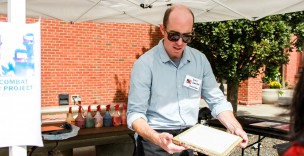
The Combat Paper Project came to the University for this past weekend, from Friday, Sept. 25 to Monday, Sept. 28. The project, which travels to various venues across the country, encourages members of the veteran and the non-veteran communities to use traditional papermaking techniques to create paper, prints, books, and art by hand out of military uniforms.
According to its website, the project, based in San Francisco, is also affiliated with paper mills in New Jersey, New York, and Nevada. So far, the Combat Paper Project has not only traveled throughout the United States, to Canada, various regions of the United Kingdom, and Kosovo.
The event opened with an exhibit on Friday, continued with two workshops and a demonstration on Saturday and Sunday, and concluded with a talk by the artist, Drew Cameron, on Monday.
According to Cameron, the co-founder of the Combat Paper Project and an Iraq war veteran, this project began in 2007 when he first turned his own uniform into paper. Not only do the papermaking workshops and lectures teach participants a new skill, they also pave the way for a larger discussion about civilians’ and soldiers’ collective understanding of war.
“It became relevant to a lot of other people immediately because so many people are connected to the military,” said Cameron. “I would argue everybody [is]. So this is a [project] that provides some sort of creative process to engage with that.”
The University’s event page for the Combat Paper Project included an excerpt of Cameron’s writing, where he further explains the rationale behind the workshops and project.
“All of our experiences are encoded within the material items we carry about. With clothing, and military uniforms, our personal geographies, memories, and accomplishments are carried in the woven threads,” the page reads. “Through the hand papermaking process, the clothing is deconstructed, transformed, and altered into paper sheets that accentuate those individual and collective stories.”
Following the workshops, the finished products were displayed in Usdan featuring a range of prints on made from old military clothing, centered on the theme of combat.
“We could take any old plant based fiber and make paper from it, or we could also take fiber that comes from a very meaningful place and transform it into paper,” Cameron said. “Then the paper that we’ve created has that added intention and added conceptual element to it.”
Cameron describes the project as a method of sharing experiences and stories.
“All of our experiences are encoded within the material items we carry about,” Cameron at the exhibit. “With clothing, and military uniforms, our personal geographies, memories, and accomplishments are carried in the woven threads. Through the hand paper-making process, the clothing is deconstructed, transformed, and altered into paper sheets that accentuate those individual and collective stories.”
To this end, the Combat Paper Project also conducts workshops to teach papermaking as a form of art therapy.
Another point of inspiration for this project is Cameron’s passion for crafting paper.
“I really love paper,” Cameron said. “By studying that craft I was especially turned onto the premise of making paper from clothing that had some sort of personal or socially symbolic reference point first.”
During the interactive workshops that were held for the public, Cameron helped everyone in attendance create and decorate their own pieces of paper. Participants had many options to personalize their projects with a variety of stencils.
Library Assistant of Scores and Recordings, the World Music Archives, and Special Collections and Archives Jennifer Hadley saw this as a great community event.
“[It’s] a great way to have something where the Posse vets, all the students, and community members are welcome to come [to], participate together, communicate, and make art,” Hadley said. “I’ve had inquiries from students at Wesleyan, vets from the VA program, and local Middletown vets about the talk on Monday.”
Cameron views the project as a connection between the arts and the military.
“It’s a way to do something creative, positive, and communal through the arts,” Cameron said. “It’s also connected to the military.”
The project has been receiving positive feedback from students. Andrew Olivieri ’18, a member of the Posse foundation, found the event especially meaningful from the perspective of a veteran.
“Projects like his help bridge the gap between veterans and civilians,” Olivieri wrote in an email to The Argus. “It shows that we’re normal, and not all of us are these grumpy old vets who believe the best days of our lives were in the military. Making paper with Drew and other students was therapeutic in a sense because me and several other vets answered questions from curious students about the military life as we snipped uniforms together.”
Arielle Schwartz ’19 attended and participated in one of the interactive workshops.
“The idea behind the Combat Paper Project is really inspiring,” Schwartz said. “It’s amazing to see this beautiful art come from something as terrible as war. It’s also really cool to think about the fact that in the paper I made are particles of clothing that were once on a soldier’s body as they fought somewhere in the world.”


Leave a Reply